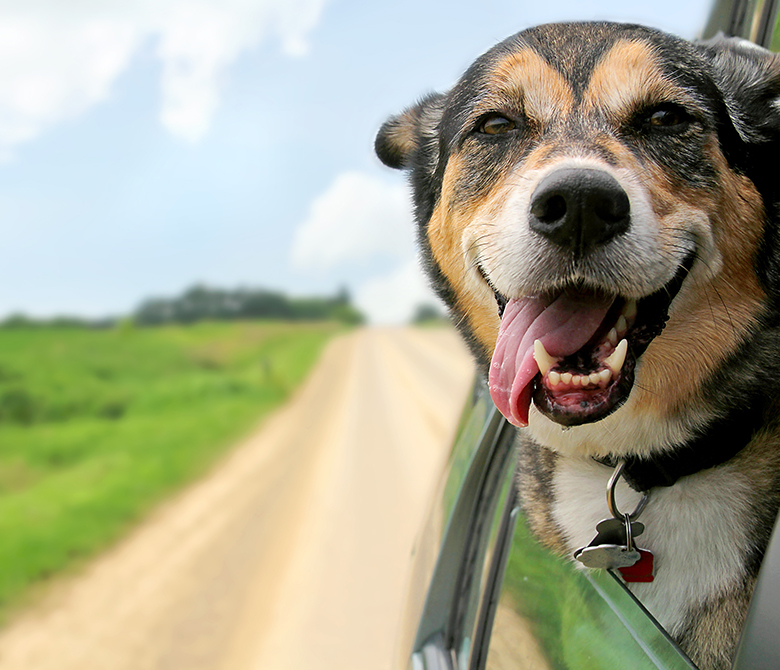Traveling with your Pet
Traveling with your Pet
Are you planning a trip, but can't decide whether to bring your pet? Going on a trip doesn't mean that you have to leave your dog behind. That's right! Bringing your dog on a trip is a great way for them to get exercise, experience new sights and smells, and spend quality time with you.
Although vacations are fun for both you and your pet, you should be aware of the responsibilities as well as precautions involved with bringing along your furry friend. In this section you will find information that will help you and your pet have a fun and safe trip.
Planning and Preparation
Planning and preparation are necessary when traveling with family pets. Consider whether your pet is comfortable when traveling. Some animals, like some people, function better in familiar surroundings. A car-sick animal can make a trip miserable for everyone. Some ill or physically impaired dogs and cats cannot withstand the rigors of travel. If this is the case, discuss options such as using a reliable pet-sitter or a clean, well-managed boarding facility with your veterinarian.
If you will be staying with friends along the way, be considerate. Find out in advance if the pet is welcome. The same goes for hotels, motels, parks, and campgrounds. Always check whether pets are allowed or kennel facilities are available. If the pet must be left alone in a hotel room, place a "Do Not Disturb" sign on the door and inform the maid and the front desk. Consider bringing along a portable kennel for use in hotel rooms or the homes of friends or relatives who are not comfortable with your pet loose when no one is home.
A few general tips apply whether you travel by car or plane. Be sure your pet is properly identified with a current tag or a microchip. Grooming (bathing, combing, trimming nails) before a trip, plus having its favorite food, toy(s), and dishes available will make your pet more comfortable. Have both proof of rabies vaccination and a current health certificate with you when crossing state or international borders. Before undertaking any trip, consult your veterinarian to be sure that all required vaccinations are up-to-date and to receive a health certificate within ten days of travel.
Airplane
Air travel is of most concern to pet owners.
You can minimize the chances of an unpleasant experience by following a few guidelines. Federal regulations require that pets be at least 8 weeks old and weaned at least 5 days before flying. Generally, a health certificate (which is not more than 10 days old) must be available before pets will be permitted to fly. A valid rabies vaccination certificate will also be required. Contact the airline well in advance for specific regulations and to secure your pet's reservation. Try to book a nonstop, midweek flight and avoid plane changes if possible. During warm weather periods choose early morning or late evening flights. In colder months, choose midday flights. Arrive at the airport early, exercise your pet, personally place it in its crate, and pick up the animal promptly upon arrival. Do not take leashed animals on escalators.
Car
If your pet is not accustomed to car travel, take it for a few short rides before your trip.
Cats should be confined to a cage or crate to allow them to feel secure and to avoid having a pet under your feet while driving. Stick to your regular feeding routine and give the main meal at the end of the day or when you reach your destination. Feeding dry food will be more convenient, assuming your pet readily consumes it. Dispose of unused canned food unless it can be refrigerated. Take along a plastic jug of cold water in case other reliable water sources are not available. Give small portions of food and water and plan to stop every two hours for exercise. Remember to include a leash with your pet's traveling supplies.
Pets should not be allowed to ride with their heads outside car windows. Particles of dirt can enter the eyes, ears, and nose, causing injury or infection.
If you must leave your pet in a parked car, be sure to lock all doors, park in a shady area, and open windows wide enough to provide ventilation without enabling your pet to jump out or get its head caught. Be aware of weather conditions. You should not leave your pet in a parked car when the temperature and/or humidity are high or when temperatures are near or below freezing.
Bus or Train
Most states prohibit animals from riding on buses and similar regulations restrict travel on trains. Exceptions are made for guide and service dogs accompanying blind and disabled persons. Consult your local carriers in advance for information.
Camping
Camping with pets presents its own challenges.
Skunks, raccoons, porcupines, snakes, and other wildlife can bite or otherwise injure your pet. Keep your pet within sight and on a leash. Be considerate of other campers. Be sure to ask your veterinarian about flea, tick and heartworm prevention.

